After Thrustmaster released the SF1000 to rave reviews (ours included), its next release the T-GT II didn’t get such a warm reception. In the interim, Fanatec rocked up with their long-awaited CSL DD and blew the market to bits.
The competition had a lot of catching up to do. But then, Thrustmaster released a roadmap for what looked to be the rest of 2021 and into 2022, with one of those products being a direct drive wheelbase.
Might it go up against the CSL DD in terms of price? We’ll have to wait and see. But one thing we didn’t have to wait to see was the Thrustmaster T248 Hybrid Drive wheel bundled with the fresh T3PM pedals.
Elephant in the room, what exactly is ‘hybrid drive’ when it’s at home? This base combines both gear and belt-driven systems to deliver 70 per cent more force feedback than 2015’s T150 – a wheel still going strong today. But the T248 isn’t actually going up against or replacing the T150 since it’s double the price. Instead, Thrustmaster looks to be targeting the likes of the Logitech G923 based on price point and features. So let’s take a closer look.
In the box, you’ll get the wheel rim and base itself, the T3PM pedals, a power supply, a USB-C to USB-A cable, a replacement spring for your brake pedal and the two-part mounting apparatus for sticking the wheel on your desk.
irstly, a big thumbs up for using USB-C, especially since there are still products out there using the archaic Micro USB still. The base itself is actually surprisingly small, reminiscent almost of the CSL DD’s size relative to a wheel, but it and the wheel are pretty much entirely made of plastic. Strong plastic, it doesn’t at all feel flimsy, but plastic nonetheless.
The buttons across the wheel are placed ergonomically and feel sturdy, though the silver rocker switches on either side of the rim have a lot less travel than I expected. They don’t require much movement to actuate, so while they are quick, it could be something you’ll catch when reaching for another button. The circumference of the rim features a slightly soft-touch material featuring a modicum of padding, but the stand out feature of the T248 is the dashing little digital display atop the centre of the wheel.
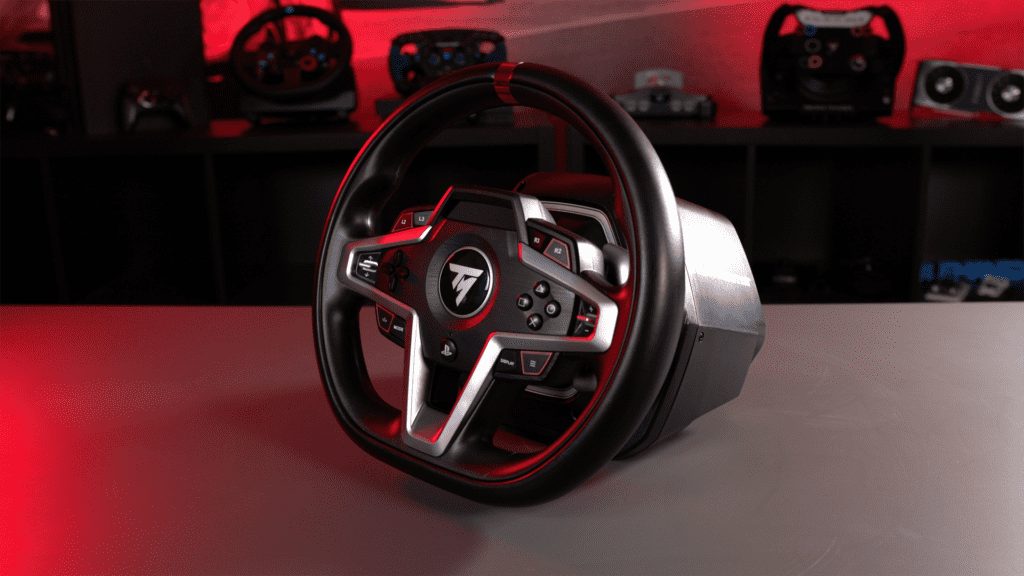
The straightforward screen can be customised to your liking, be it showing your revs, gear, position, lap times, or speed, and the rectangular segments on the bottom of the display represent your rev lights across every numerical setting.
You can even customise the direction they go in or turn them off entirely. But one of the best things about all this customisation is, thanks to that display, it’s done on the fly on the wheel itself. Not only can you customise what is displayed, but you can also change other settings, such as the compatibility mode between PC, PS4 and PS5 – sorry Xbox users, this isn’t going to work for you.
You can also change the degrees of rotation, force feedback settings, whether the pedals around mounted normally or inverted and view information about firmware and connected peripherals. Compatibility-wise, Thrustmaster is looking for most games to support this display, but as of the time of writing, only a handful of games are compatible. We are reviewing this pre-release, so this will change in the future.
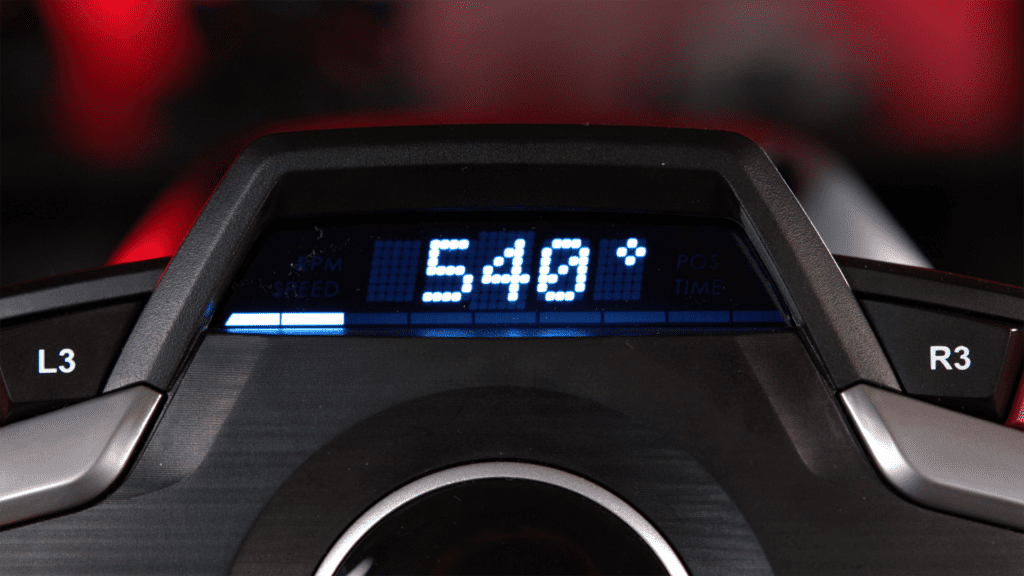
The included pedals are the T3PM model, which look very similar to the existing T-LCM pedals and feature similar magnetic operation, but with no load cell and less metal construction.
Though solid once more, plastic strikes again. The underside features five threaded holes if you wanted to mount these pedals to a rig, and three meagre-feeling rubber pads to at least try and keep it sturdy if you’re just putting them on the floor. I recommend having these pedals against the wall under your desk to avoid movement.
The pedals feature cable channels so you can output the RJ12 connector to either side of the base which is nice, and the underside of the wheelbase itself features little cable channels to keep things neat, with a built-in velcro strap to keep everything together. You’ve also got a shifter socket if you’re wanting to drive stick or whack a handbrake on too.
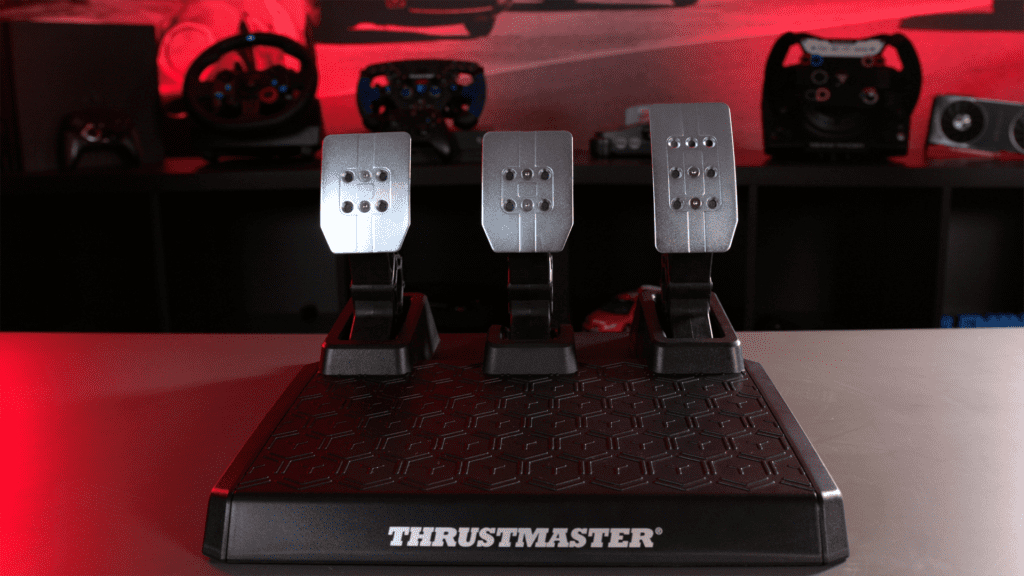
The pedals feel fine under normal usage, but as I mentioned earlier you do get a heavier spring in the box, so you can tweak the pressure on the pedal using a mix of the stock silver spring, the included black one, and adding and removing the cushion spacer for a total of four different strengths.
The brake pedal configuration out of the box is acceptable, with a smooth travel and a constant resistance, but if you’re wanting a better feeling brake, definitely swap out the stock spring for the black one, with the cushion too for arguably the best feeling. As said earlier though, if you’re not against a wall and susceptible to slide-y pedals, maybe stick to the stock brake, or even take the cushion out and make it lighter. But the fact you get these options out the box is pretty great – a suprise these aren’t aftermarket products you had to pay for.
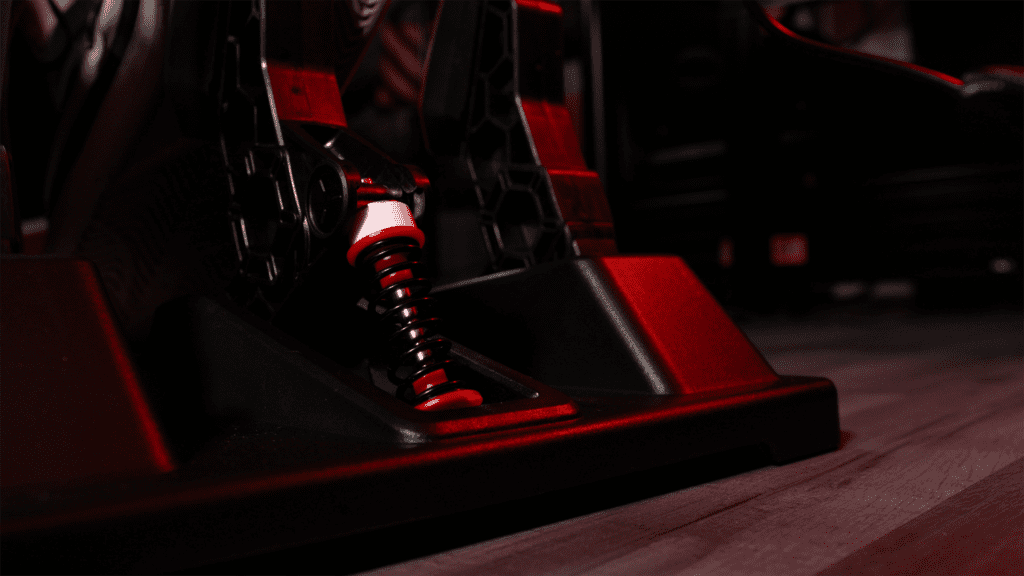
With everything plugged in and running, the hybrid drive system feels really satisfying. With the expected 900° of rotation, the mix of belt and gear gives the force feedback enhanced clarity. Going over kerbs feels spectacular, and it does have a little punch as and when it needs to.
The steering feels precise enough, but it is pretty heavy overall. Playing with settings in-game did decrease some of the feedback, but the weighty stiffness remained. But if weighty steering is fine and you’re after an extra little kick, that’s where those extra force feedback modes built into the wheel come in. FFB 1 outputs exactly how the game wants, whereas FFB 2 and 3 gives it just a little more sauce.
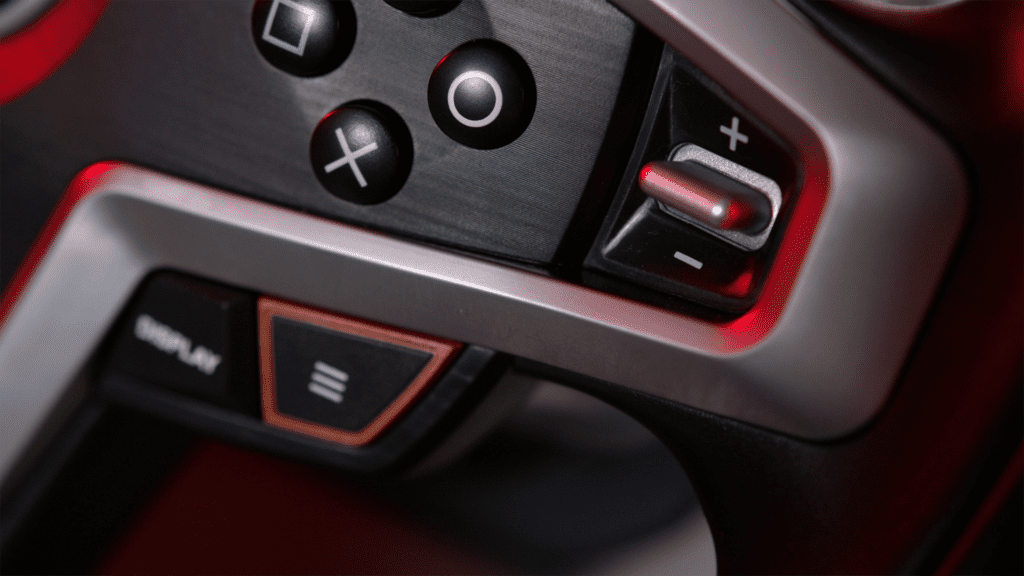
However, things aren’t all peaches and cream for the T248. This hybrid system has led to an almost scratchy feeling upon rotation, which almost brings its longevity into question. The amount this wheel will actually kick you back is okay, but if you’re wanting something that will throw you around, it’s not going to be the T248.
The build quality is sturdy and doesn’t feel overly cheap, but it is all plastic. If we’re going to put this up against the likes of the G923 and T150, both of those have more metal in their construction, and that’s with the T150 being half the price. They both have metal shifter paddles for example, but the T248 doesn’t. This quite nicely leads me on to what I dislike most about the wheel.
The shifter paddles might have buzzwords and magnetic gobbledegook aplenty to put these across as something truly special, but upon using them, I would go as far as to say they put me off the wheel as a whole. The force needed to actuate is pretty heavy for paddles I’d say, and worst of all they are incredibly loud.
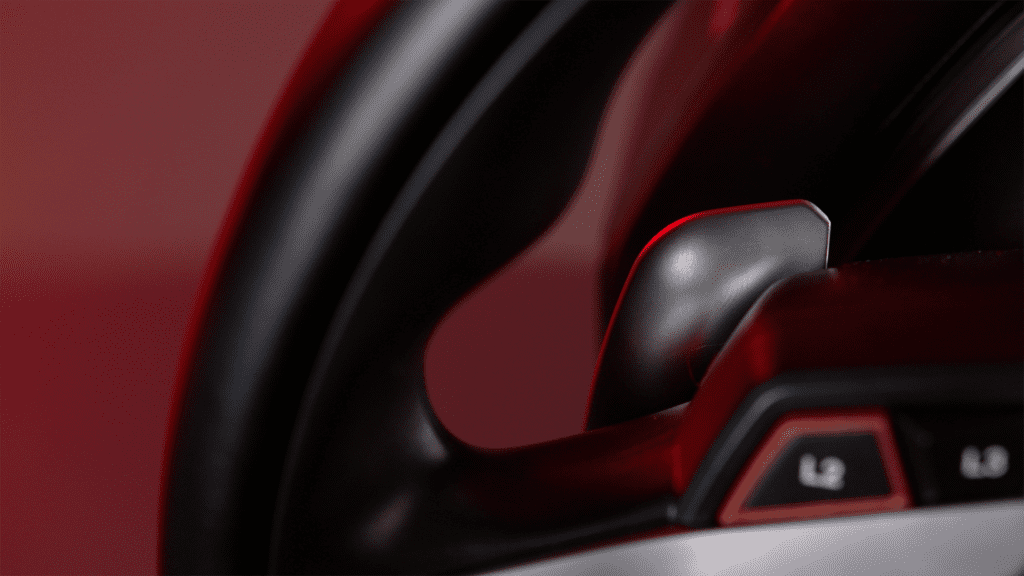
If you’re playing in a room by yourself with your headphones on, you’ll barely notice. But if say you’ve got a rig set up in your living room separate from your usual TV, you’re thinking about picking up some of these for a sim racing venue or you’re in an online part chat, be warned that these shifters are vociferous.
To quote the official product page, the “T248’s paddle shifters allow for super-fast gear shifting, with clear and precise activation feel (30ms response time) […] This proprietary technology (is) based on a contactless system of magnets without any friction.”
Maybe this is me being really picky, but the terms ‘super-fast’ and ‘contactless without any friction’ shouldn’t in my opinion result in these heavy and incredibly loud shifter paddles. It’s honestly the most disappointing aspect of this wheel.
Sadly, the positioning of the display on this wheel isn’t ideal either. If you sat in a cockpit with the wheel visually a bit higher up in your periphery, then it might be more useful. But if you’ve got it on a desk like I assume most of you would, you’ll barely notice it. Plus, since this is a very simple LCD dot matrix display, the vertical viewing angle has a bit of a dead zone, and on average, it looks to be from almost the exact angle you’ll be sitting.
So much like the SF1000’s gorgeous display, the usability is almost gimmicky. It’s not a bad inclusion by any stretch, the on-the-fly adjustments are fantastic (especially for console players), but much like any display on a wheel I guess, it may not be all that useful depending on how and if you use it – at least when you’re mid-race.
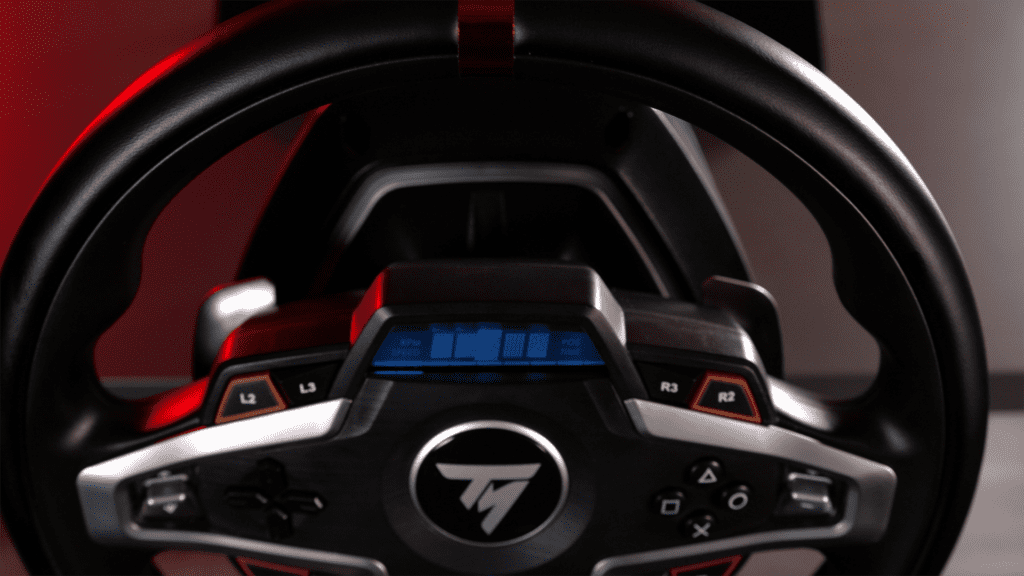
Let’s get to the price. The T248 and T3PM pedals together in the box will set you back £299.99 (€349.99/$399.99). Now let’s put that against the aforementioned pairing of the Thrustmaster T150 and Logitech G923, priced at £149.99 (€229.99/$199.99) and £349.99 (€399.00/$399.99) respectively.
When you look at the comparable price point, the T248 is only really going up against the G923, but we’re including the T150 here since the marketing and press speak from Thrustmaster references this model.
You get more power from the T248 over the T150, and definitely a more robust, heavy feedback compared to the G923 – so points to the T248. Build quality is almost out of the question if you include the T150 since it’s quite the price drop (but still has metal paddles), but this round goes to the G923 since it feels far more premium in its construction, with metal across the face of the wheel, shifters, and the lovely leather rim. Plus the pedals are entirely metal, not just the faces like on the T3PM.
Though, I will give button placement to the T248. It feels a lot more straightforward and similar to other wheels across all brands. The G923 is a bit wacky in this regard. Button feel is almost negligible I guess, both are very similar. As said earlier, both readouts suffer from ‘being in not an entirely great place syndrome’, so no points there, and in terms of software, Thrustmaster has some to update the firmware, but everything else you can do on the fly, while Logitech uses the sometimes-temperamental G HUB.
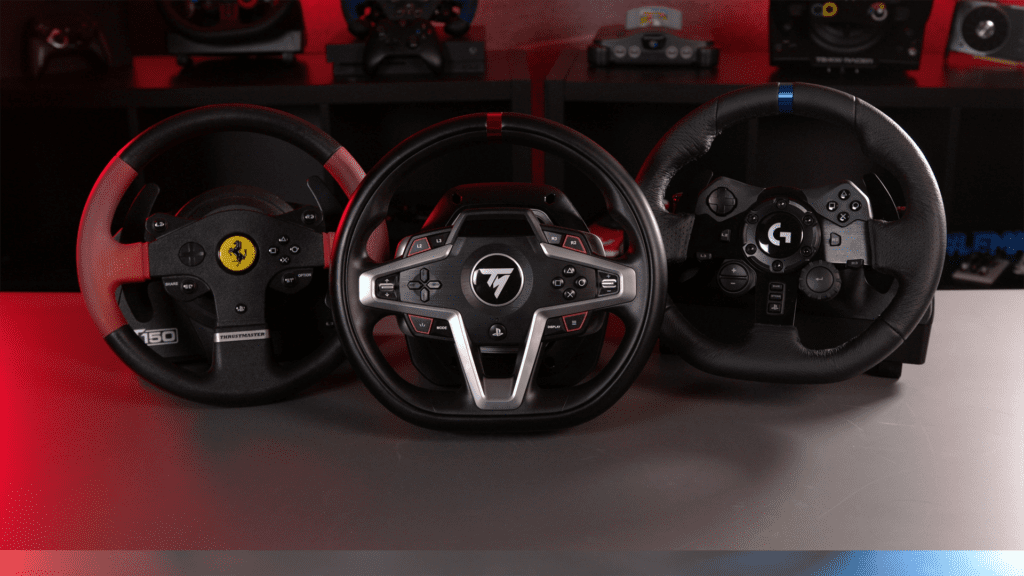
Finally, I want to outline how these wheels look. This is almost an irrelevant area to some, but not all. I’m definitely one who takes aesthetics into serious account. This is definitely a point you can take or leave; this isn’t something that should necessarily swing your personal decision, but I want to talk about it anyway.
It might just be me, but Thrustmaster’s visual style makes their products look a lot cheaper than they are. They feel great, but in my eyes don’t always look the part. You might think the T248 looks like the mutts nuts, but I’m not in that camp. The thick silver and brushed plastic front cheapen what could be a truly gorgeous wheel, and the stodgy paddles don’t help either.
A nicer looking and feeling rim probably wouldn’t go amiss, and those rubber feet on the pedals need a good talking to. But that’s me, I just wanted to vent a little. Visuals aside, when in use this wheel is great.
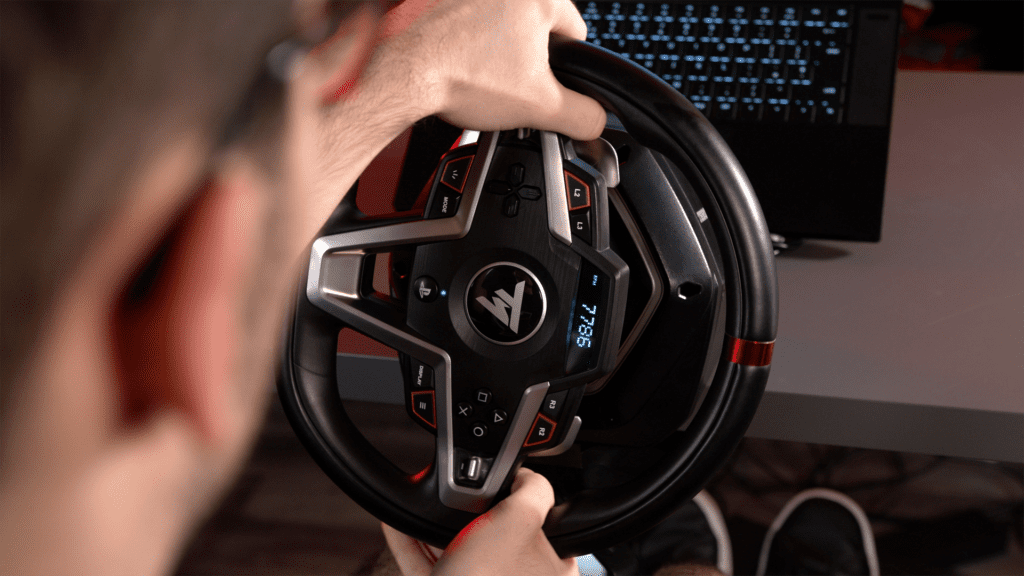
So is the Thrustmaster T248 worth it? It’s not exactly a budget wheel, that’s why the T248 exists – but if you’re wanting something not super entry-level and not to begin your serious esports career, it’s definitely a solid choice.
It’s a robust wheel with great force feedback, fantastic on-the-fly control over a bunch of settings, and the button placement is bang-on. Though the steering is heavy and sort of scratchy, and the less said about these big clunkers the better.
Pitting it against what is arguably its main rival, the G923, it’s a toss-up. Personal preference if you will. The G923 is £50 more expensive, but it’s pretty much always on offer in some way, shape, or form. But if you like how it looks, want to work those arms playing DiRT Rally 2.0, and have a need to bling up your desk a little, the T248 is the way to go.
Full disclosure: The equipment was kindly provided by the manufacturer for review purposes Here is our review policy.

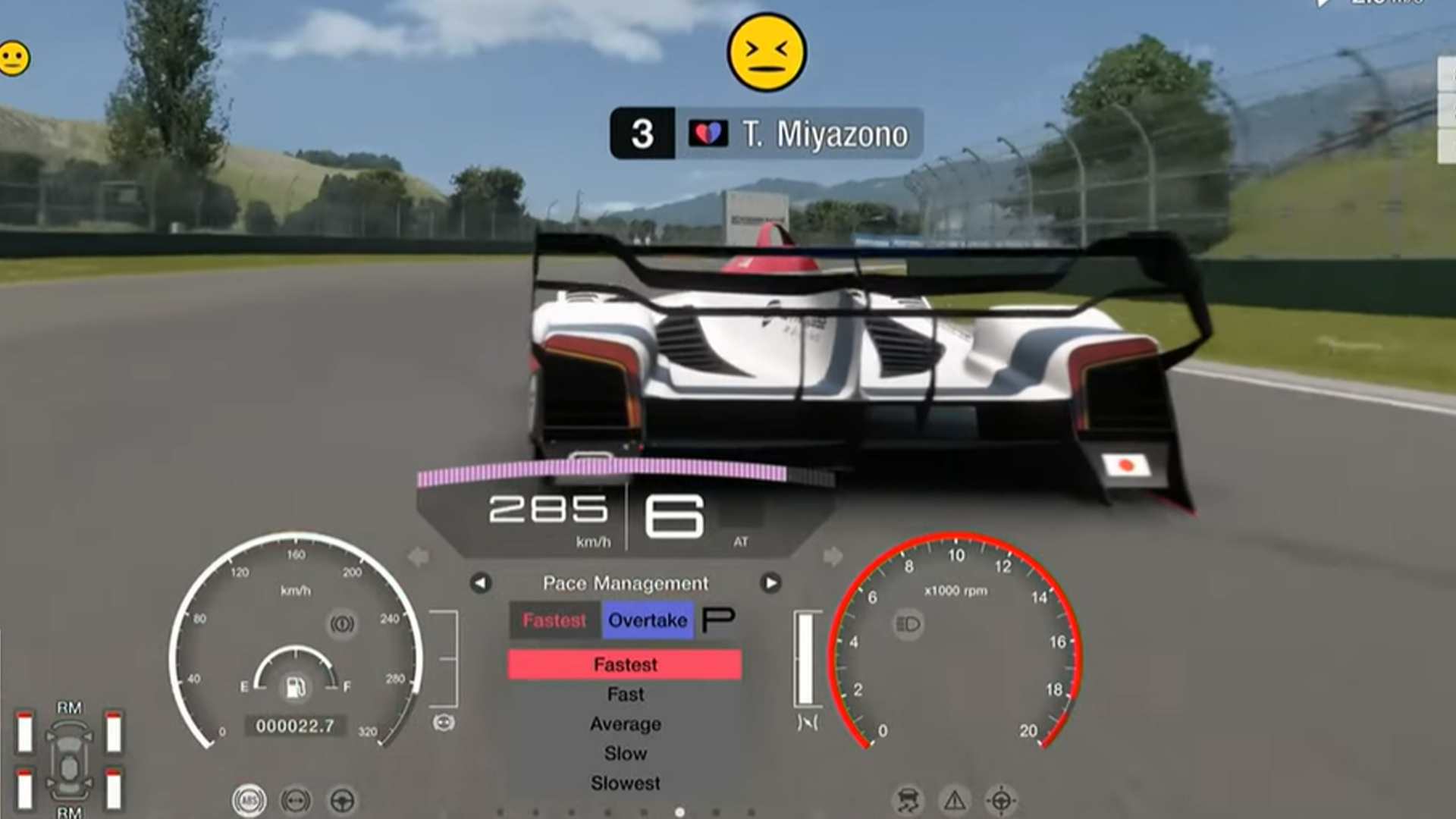


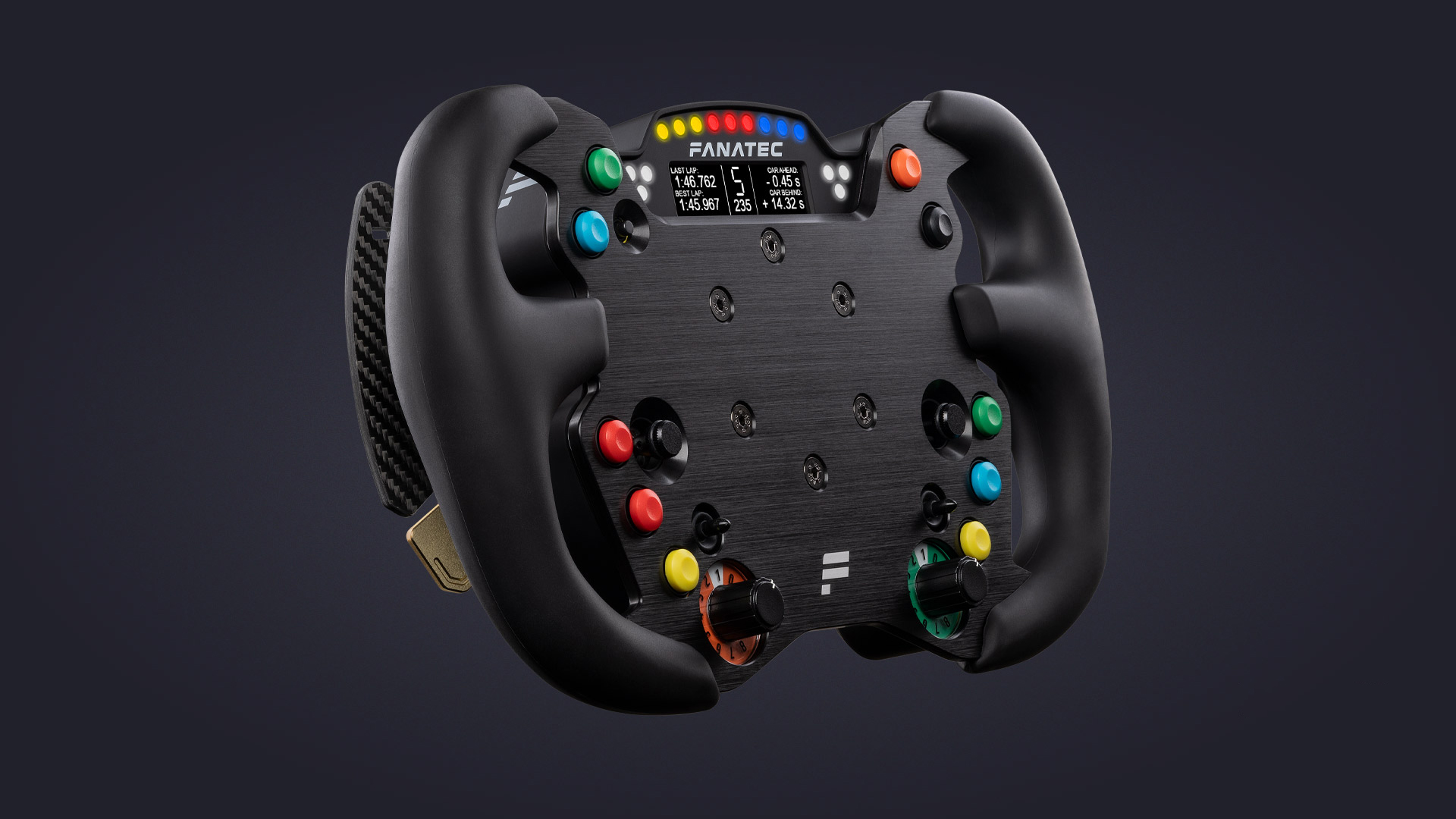
Chat with the Community
Sign Up To CommentIt's completely Free